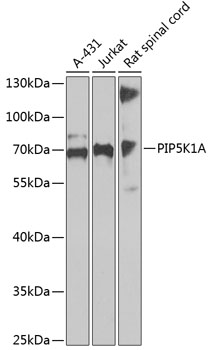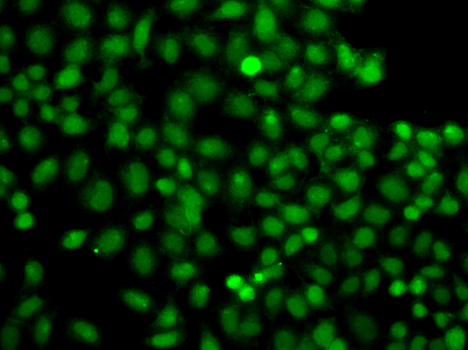Cell Biology Antibodies 3
Anti-PIP5K1A Antibody (CAB13374)
- SKU:
- CAB13374
- Product Type:
- Antibody
- Reactivity:
- Human
- Reactivity:
- Rat
- Host Species:
- Rabbit
- Isotype:
- IgG
- Antibody Type:
- Polyclonal Antibody
- Research Area:
- Cell Biology
Description
| Antibody Name: | Anti-PIP5K1A Antibody |
| Antibody SKU: | CAB13374 |
| Antibody Size: | 20uL, 50uL, 100uL |
| Application: | WB IHC IF |
| Reactivity: | Human, Rat |
| Host Species: | Rabbit |
| Immunogen: | Recombinant fusion protein containing a sequence corresponding to amino acids 231-500 of human PIP5K1A (NP_001129109.1). |
| Application: | WB IHC IF |
| Recommended Dilution: | WB 1:500 - 1:2000 IHC 1:50 - 1:200 IF 1:50 - 1:200 |
| Reactivity: | Human, Rat |
| Positive Samples: | A-431, Jurkat, Rat spinal cord |
| Immunogen: | Recombinant fusion protein containing a sequence corresponding to amino acids 231-500 of human PIP5K1A (NP_001129109.1). |
| Purification Method: | Affinity purification |
| Storage Buffer: | Store at -20'C. Avoid freeze / thaw cycles. Buffer: PBS with 0.02% sodium azide, 50% glycerol, pH7.3. |
| Isotype: | IgG |
| Sequence: | MNNL LPRS VKMH IKYD LKGS TYKR RASQ KERE KPLP TFKD LDFL QDIP DGLF LDAD MYNA LCKT LQRD CLVL QSFK IMDY SLLM SIHN IDHA QREP LSSE TQYS VDTR RPAP QKAL YSTA MESI QGEA RRGG TMET DDHM GGIP ARNS KGER LLLY IGII DILQ SYRF VKKL EHSW KALV HDGD TVSV HRPG FYAE RFQR FMCN TVFK KIPC VHLG RPDV LPQT PPLE EISE GSPI PDPS FSPL VGET LQML TTST TLEK LEVA ESEF TH |
| Gene ID: | 8394 |
| Uniprot: | Q99755 |
| Cellular Location: | Cell membrane, Cell projection, Cytoplasm, Nucleus speckle, ruffle |
| Calculated MW: | 56kDa/58kDa/61kDa/62kDa |
| Observed MW: | 63kDa |
| Synonyms: | PIP5K1A |
| Background: |
| UniProt Protein Function: | PIP5K1A: Catalyzes the phosphorylation of phosphatidylinositol 4- phosphate (PtdIns4P) to form phosphatidylinositol 4,5-bisphosphate (PtdIns(4,5)P2). PtdIns(4,5)P2 is involved in a variety of cellular processes and is the substrate to form phosphatidylinositol 3,4,5-trisphosphate (PtdIns(3,4,5)P3), another second messenger. The majority of PtdIns(4,5)P2 is thought to occur via type I phosphatidylinositol 4-phosphate 5-kinases given the abundance of PtdIns4P. Participates in a variety of cellular processes such as actin cytoskeleton organization, cell adhesion, migration and phagocytosis. Required for membrane ruffling formation, actin organization and focal adhesion formation during directional cell migration by controlling integrin-induced translocation of RAC1 to the plasma membrane. Together with PIP5K1C is required for phagocytosis, but they regulate different types of actin remodeling at sequential steps. Promotes particle ingestion by activating WAS that induces Arp2/3 dependent actin polymerization at the nascent phagocytic cup. Together with PIP5K1B is required after stimulation of G-protein coupled receptors for stable platelet adhesion. Plays a role during calcium-induced keratinocyte differentiation. Recruited to the plasma membrane by the E-cadherin/beta-catenin complex where it provides the substrate PtdIns(4,5)P2 for the production of PtdIns(3,4,5)P3, diacylglycerol and inositol 1,4,5-trisphosphate that mobilize internal calcium and drive keratinocyte differentiation. Together with PIP5K1C have a role during embryogenesis. Functions also in the nucleus where acts as an activator of TUT1 adenylyltransferase activity in nuclear speckles, thereby regulating mRNA polyadenylation of a select set of mRNAs. Interacts with RAC1. Interacts with TUT1. Forms a complex with CDH1/E-cadherin, CTNNB1/beta-catenin and CTNND1 at the plasma membrane upon calcium stimulation. Highly expressed in heart, placenta, skeletal muscle, kidney and pancreas. Detected at lower levels in brain, lung and liver. 4 isoforms of the human protein are produced by alternative splicing. |
| UniProt Protein Details: | Protein type:Carbohydrate Metabolism - inositol phosphate; Kinase, lipid; EC 2.7.1.68; Motility/polarity/chemotaxis Chromosomal Location of Human Ortholog: 1q21.3 Cellular Component: cytoplasm; cytosol; focal adhesion; lamellipodium; mRNA cleavage and polyadenylation specificity factor complex; nuclear speck; nucleoplasm; nucleus; plasma membrane Molecular Function:1-phosphatidylinositol-3-phosphate 5-kinase activity; 1-phosphatidylinositol-4-phosphate 5-kinase activity; kinase binding; protein binding Biological Process: actin cytoskeleton reorganization; focal adhesion formation; glycerophospholipid metabolic process; keratinocyte differentiation; phagocytosis; phosphatidylinositol biosynthetic process; phospholipid biosynthetic process; regulation of phosphoinositide 3-kinase cascade; signal transduction |
| UniProt Code: | Q99755 |
| NCBI GenInfo Identifier: | 74752158 |
| NCBI Gene ID: | 8394 |
| NCBI Accession: | Q99755.1 |
| UniProt Secondary Accession: | Q99755,Q99754, Q99756, A8K4Q0, B4DIN0, |
| UniProt Related Accession: | Q99755 |
| Molecular Weight: | 58,119 Da |
| NCBI Full Name: | Phosphatidylinositol 4-phosphate 5-kinase type-1 alpha |
| NCBI Synonym Full Names: | phosphatidylinositol-4-phosphate 5-kinase type 1 alpha |
| NCBI Official Symbol: | PIP5K1A |
| NCBI Protein Information: | phosphatidylinositol 4-phosphate 5-kinase type-1 alpha |
| UniProt Protein Name: | Phosphatidylinositol 4-phosphate 5-kinase type-1 alpha |
| UniProt Synonym Protein Names: | 68 kDa type I phosphatidylinositol 4-phosphate 5-kinase alpha; Phosphatidylinositol 4-phosphate 5-kinase type I alpha; PIP5KIalpha |
| Protein Family: | Phosphatidylinositol 4-phosphate 5-kinase |
| UniProt Gene Name: | PIP5K1A |
| UniProt Entry Name: | PI51A_HUMAN |





![Anti-PIP5K1A Antibody (CAB18025)[KO Validated] Anti-PIP5K1A Antibody (CAB18025)[KO Validated]](https://cdn11.bigcommerce.com/s-rd6ounxcu2/images/stencil/590x590/products/55170/59913/anti-pip5k1a-antibody-cab18025ko-validated__49138__03349.1706529186.jpg?c=1)
![Anti-PIP5K1A Antibody (CAB18099)[KO Validated] Anti-PIP5K1A Antibody (CAB18099)[KO Validated]](https://cdn11.bigcommerce.com/s-rd6ounxcu2/images/stencil/590x590/products/55239/59982/anti-pip5k1a-antibody-cab18099ko-validated__35053__00476.1706529214.jpg?c=1)

